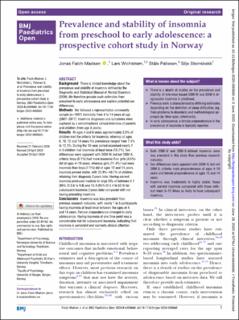| dc.contributor.author | Falch-Madsen, Jonas | |
| dc.contributor.author | Wichstrøm, Lars | |
| dc.contributor.author | Pallesen, Ståle | |
| dc.contributor.author | Steinsbekk, Silje | |
| dc.date.accessioned | 2020-09-16T06:36:40Z | |
| dc.date.available | 2020-09-16T06:36:40Z | |
| dc.date.created | 2020-06-08T14:53:08Z | |
| dc.date.issued | 2020 | |
| dc.identifier.issn | 2399-9772 | |
| dc.identifier.uri | https://hdl.handle.net/11250/2677923 | |
| dc.description.abstract | Background There is limited knowledge about the prevalence and stability of insomnia defined by the Diagnostic and Statistical Manual of Mental Disorders (DSM). We therefore provide such estimates from preschool to early adolescence and explore potential sex differences.
Methods We followed a representative community sample (n=1037) biennially from 4 to 14 years of age (2007–2017). Insomnia diagnoses and symptoms were captured by a semistructured clinical interview of parents and children (from age 8 years).
Results At ages 4 and 6 years approximately 2.5% of children met the criteria for insomnia, whereas at ages 8, 10, 12 and 14 years the prevalence ranged from 7.5% to 12.3%. During the 10-year period examined nearly 1 in 5 children had insomnia at least once (18.7%). Sex differences were apparent with DSM-IV, but not DSM-5, criteria: boys (8.1%) had more insomnia than girls (4.5%) did at ages 4–10 years, whereas girls (11.4%) had more insomnia than boys (7.1%) did at ages 12 and 14 years. Insomnia proved stable, with 22.9%–40.1% of children retaining their diagnosis 2 years later. Having current insomnia produced medium to large ORs of between 5.1 (95% CI 2.6 to 9.8) and 15.3 (95% CI 4.4 to 52.9) for subsequent insomnia 2 years later compared with not having preceding insomnia.
Conclusions Insomnia was less prevalent than previous research indicates, with nearly 1 in 5 participants having insomnia at least once between the ages of 4 and 14 years. Female preponderance emerged in early adolescence. Having insomnia at one time point was a considerable risk for subsequent insomnia, indicating that insomnia is persistent and warrants clinical attention | en_US |
| dc.language.iso | eng | en_US |
| dc.publisher | BMJ Publishing Group | en_US |
| dc.rights | Navngivelse-Ikkekommersiell 4.0 Internasjonal | * |
| dc.rights.uri | http://creativecommons.org/licenses/by-nc/4.0/deed.no | * |
| dc.title | Prevalence and stability of insomnia from preschool to early adolescence: a prospective cohort study in Norway | en_US |
| dc.type | Peer reviewed | en_US |
| dc.type | Journal article | en_US |
| dc.description.version | publishedVersion | en_US |
| dc.source.journal | BMJ Paediatrics Open | en_US |
| dc.identifier.doi | 10.1136/bmjpo-2020-000660 | |
| dc.identifier.cristin | 1814406 | |
| dc.description.localcode | © Author(s) (or their employer(s)) 2020. Re-use permitted under CC BY-NC. No commercial re-use. See rights and permissions. Published by BMJ. | en_US |
| cristin.ispublished | true | |
| cristin.fulltext | original | |
| cristin.qualitycode | 1 | |

